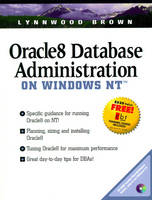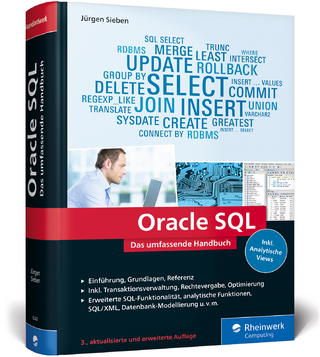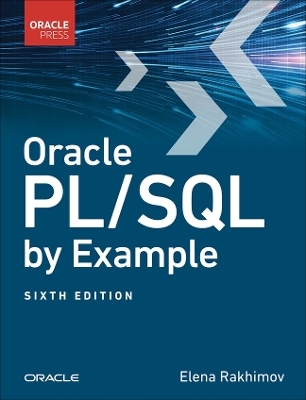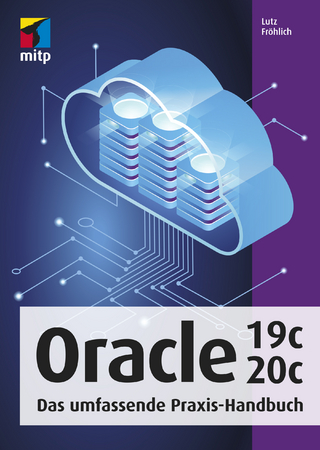
Oracle8 Database Administration on Windows NT
Prentice Hall (Verlag)
978-0-13-927443-5 (ISBN)
- Titel ist leider vergriffen;
keine Neuauflage - Artikel merken
If you're running Oracle8 on Windows NT Server, all the hard-to-find DBA information you need is right here, in Oracle8 Database Administration on Windows NT. Expert Oracle DBA Lynwood Brown covers architecture, installation, tuning, security, networking, even the basics of application development with PL/SQL. Learn to use Oracle 8's GUI-based Data Manager, master the art of gathering and interpreting performance data, and much more. Soup-to-nuts coverage includes using SQL*NET and SQL*NET 2 in networked client/server environments; Oracle auditing and data integrity features; managing user accounts, backup, and recovery. The book is replete with real-world examples developed through Lynnwood Brown's years of teaching Oracle to working DBAs. The CD-ROM contains MenloSoftware's flexible, easy-to-use DBAWare 2.0 database performance analysis tool, which allows you to monitor, track and tune Oracle databases from any MS-Windows client, using provided SQL statements and stored procedures -- or your own. Plus CBT Systems Oracle8 Training Module. Don't throw away the manuals -- but this is the book you'll use every day!
Lynnwood Brownis Oracle DBA for InfoWorld, a leading IT trade publication. He teaches Oracle courses at the University of California, Berkeley Extension. He formerly worked for Oracle Corporation's Worldwide Technical Support organization. He is author of Oracle Database Administration on UNIX Systems (Prentice Hall PTR).
1. Introduction To Database Management Systems.
What and Why. What Is A Database Management System? Typical Database Applications. What Is A Data Model? Relational Database Terms. What is Oracle? Operating Systems and the Oracle RDBMS. Introducing Windows NT Introducing Oracle8. Summary.
2. The Architecture.
Oracle8 and the Windows NT. Operating System. ORACLE8 RDBMS ARCHITECTURE. Oracle Database Structure. Tablespaces. Data File Contents and Types of Segments. The Control File. The INIT.ORA File. The Memory Structures. Database Buffer And Redo Log Buffer Structure. The Oracle Process and Thread Structure. Summary.
3. System Installation.
Background. The Oracle Directory Structure. Checking The Database. Frequently Referenced Data Dictionary. Tables and Views. Licensing. Summary.
4. Client/Server Communications And SQL*NET.
Background. OSI Data Communication Model. Layer 7: Application Layer. Layer 6: Presentation Layer. Layer 5: Session Layer. Layer 4: Transport Layer. Layer 3: Network Layer. Layer 2: Link Layer. Layer 1: Physical Layer. Protocol Stacks. Network Devices. Client/Server Communications and ORACLE's SQL*NET. Configuring SQL*NET (NET8). Using the NET8 Assistant. SOL*NET Logging and Tracing. Windows95 Clients. Tracing for Windows 95 Clients. Creating and Using Database Links. MTS. MTS INIT.ORA Example. Dead Connection Detection. Sample LISTENER.ORA File.
5. Database Objects, Access And Security
Creating Database Objects. Creating aTable. Creating aView. Creating aSynonym. Example of Create Synonym. Creating a User. Database Access/Security. Object And System Privileges. Roles. Helpful Data Dictionary Views. Constraints. Types of Integrity Constraints. Referential Integrity and Foreign Key. Constraints. Loading Data. Fast Data Loading. Loading Data Using Enterprise Manager. Import/Export. Manual Database Creation. Database Auditing. Protecting the Audit Trail. Oracle Table/Database Replication. Techniques. Background. Database Replication Using Oracle SNAPSHOT. Database Replication using Copy. Database Replication Using Remote Procedure Call.
6. Database Backup/Recovery.
Physical Backup. Logical Backup. Types of Physical Backups and Database Modes. Cold Backup.Hot Backup. Database Recovery. Recovery Using a Cold Backup. Database Recovery from a Hot Backup. Open Database Recovery. Closed Database Recovery. Special Database Open Instructions. Summary.
7. Database Performance Analysis And Tuning.
Memory Management Tuning. CPU Management. Disk I/O Management. Additional Tuning Tips. Tip 1. Tip 2. Tip 3. Tip 4. Tip 5. Tip 6. Row Chaining And Migration. Correcting Migration and Chaining. Minimizing Migration And Row Chaining. Indexes and SQL Statement Tuning. Background. What Should Be Indexed? Composite Indexes. SQL Statement Analysis Tools. Setting Up TKPROF (Turning on Tracing). Types of Indexes. Summary.
8. Database Capacity Planning.
Sizing Table Segments And Tablespaces. Sizing Index Segments And Tablespaces. Sizing Rollback Segments and Tablespaces. Setting Up Rollback Segments. Sizing Temporary Segments and Tablespaces. Summary.
9. Application Development For DBAs.
Introduction. Entity-Relationship Modeling. Entity-Relationship Model Components. Normalization. How It All Fits Together. Oracle Web Assistant.
10. VLDB.
Table Striping. Partitioning Guidelines. SQL Support For Table Partitioning. Data Dictionary And Table Partitions. Migrating From Partitioned Views To Partitioned Tables. Conclusion.
Appendix A. Additions to the Oracle Data Dictionary.
Appendix B. What Is SQL?
Introduction To SQL*PLUS. Querying the Database. Loading/updating the Database. Using SQL*PLUS Functions. Introduction To PL/SQL. PL/SQL Program/Block Layout. Defining Number Variables. Defining Character Variables. Defining Date Variables. Defining Boolean Variables. Insert Example. Update Example. Delete Example. If-Then-Else Example. Simple Loop Example. Cursors. Object-Oriented SQL. The CREATE TYPE Statement. Create Type Examples. Example 1. Example 2. Example 3. Example 4. The ALTER TYPE Statement. Alter Type Examples. Example 1. Example 2. The DROP TYPE Statement. The Type Dependency Model. Creating Privileges and Auditing Types.
Appendix C. DBAware Reference.
DBAware Installation Instructions. I. Install DBAware (Required Step—All Platforms). II. RDBMS DLL (Required Step—ALL Platforms). III. Archive Data (Required Step—ALL Platforms). IV. Time Zone Preference (Required Step—all Platforms). Tuning an Oracle RDBMS—One View. Checking/Tuning the init.ora Parameters. Running and Recording Benchmarks. Continuous Monitoring. End-User SQL. DBAware 2.0 System Requirements. I. Minimum. II.Recommended. DBAware 2.0 Evaluation Tutorial. Creating a DB Connection. Creating a Query. Sybase Users. Query Operations. Drill Down Reports. Ad Hoc Query Tool. Creating Your Own Queries.
Appendix D. Product Summary.
Oracle Development Tools. Oracle Financials. Oracle Applications. Oracle Human Resource Management System.
Bibliography.
Index.
| Erscheint lt. Verlag | 10.11.1998 |
|---|---|
| Verlagsort | Upper Saddle River |
| Sprache | englisch |
| Maße | 180 x 235 mm |
| Gewicht | 623 g |
| Themenwelt | Mathematik / Informatik ► Informatik ► Betriebssysteme / Server |
| Informatik ► Datenbanken ► Oracle | |
| ISBN-10 | 0-13-927443-X / 013927443X |
| ISBN-13 | 978-0-13-927443-5 / 9780139274435 |
| Zustand | Neuware |
| Haben Sie eine Frage zum Produkt? |
aus dem Bereich


